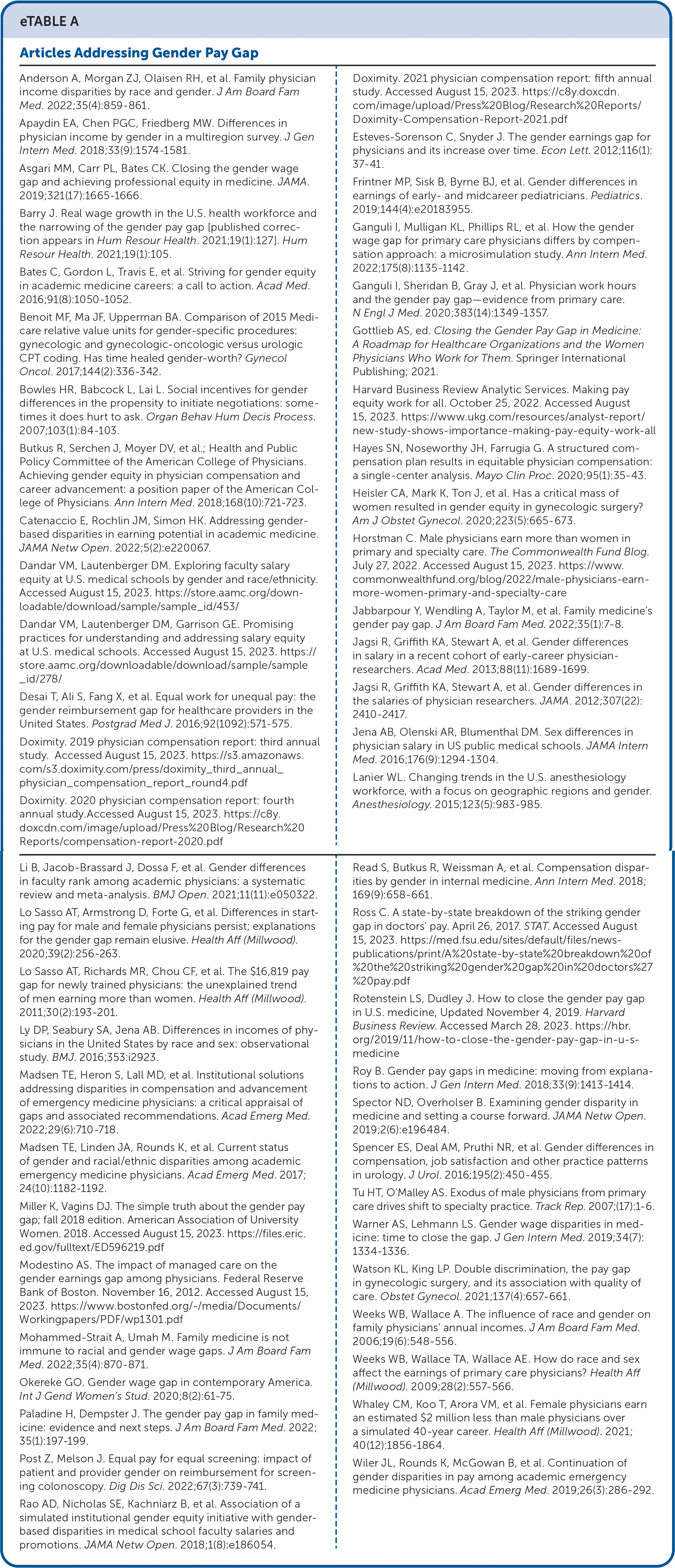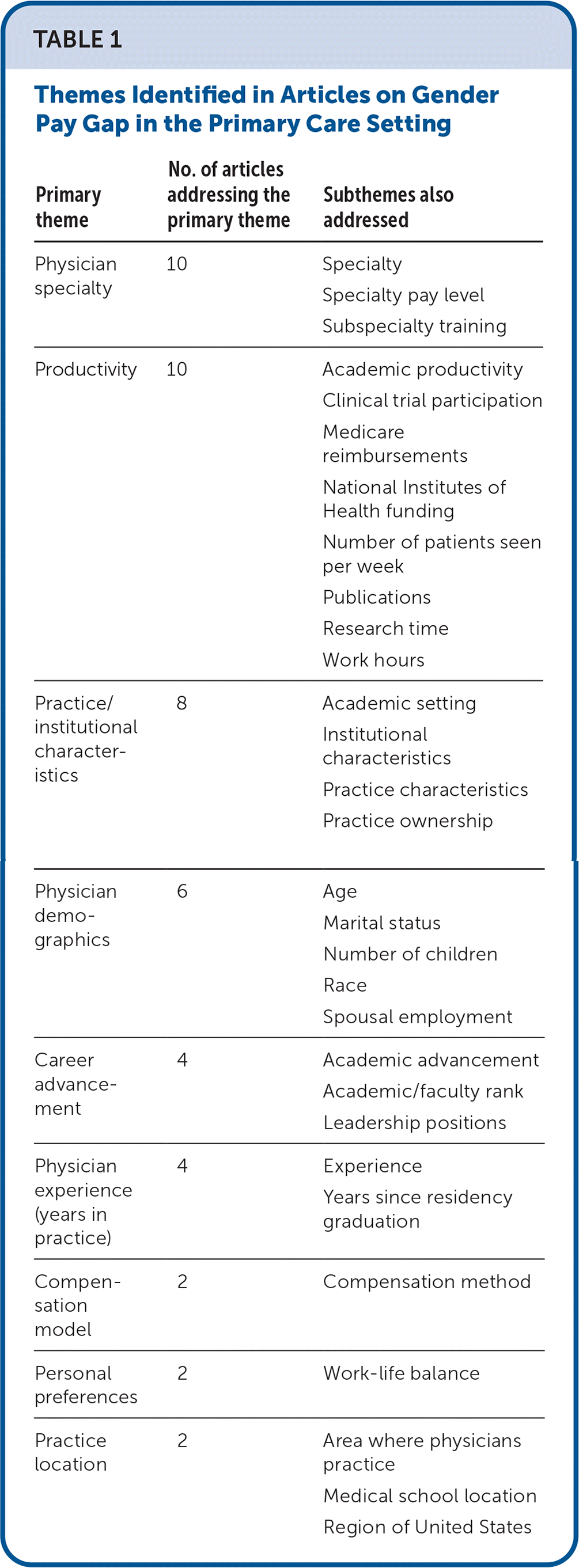
Am Fam Physician. 2023;108(4):346-347
Related Letter to the Editor: Examining Gender Disparities in Medicine
Related Letter to the Editor: Gender Bias and Pay Disparity in Medicine
Author disclosure: No relevant financial relationships.
The average salaries of female physicians are lower than those of their male peers. Previous studies demonstrate that female family physicians earn approximately 16% less than their male counterparts.1 However, multiple studies have demonstrated benefits of having a female physician, including quality of care and relationships.2,3 After controlling for multiple variables, the wage gap persists, making gender biases the most likely explanation.
The authors performed a PubMed and Google Scholar literature search for articles published since 2010 on the gender wage gap for any physician specialty. Relevant research analyses, commentaries, and editorials were included. The main theme of each article was identified and the number of articles were tabulated for each. Main themes and subthemes were verified by two authors. Earlier studies and the 2020 Medscape Family Medicine Physician Compensation Report were used to estimate the lifetime wage disparity the average female family physician may experience due to lack of pay equity.4
Fifty-five unique articles were identified that addressed the gender pay gap (eTable A); these included three blog posts, 11 commentaries or editorials, one expert review, one guideline, one lay press, 27 original research articles, and seven white papers. One article was unable to be retrieved. Sixteen articles specifically addressed primary care specialties. Table 1 lists themes found in the identified articles. Subthemes were mentioned in the analysis as secondary measures but were not the primary outcome. Of the 27 research articles, 15 explored whether the gender pay gap persisted despite a main theme; the wage gap persisted in every article.

| Anderson A, Morgan ZJ, Olaisen RH, et al. Family physician income disparities by race and gender. J Am Board Fam Med. 2022; 35(4): 859–861. Apaydin EA, Chen PGC, Friedberg MW. Differences in physician income by gender in a multiregion survey. J Gen Intern Med. 2018; 33(9): 1574–1581. Asgari MM, Carr PL, Bates CK. Closing the gender wage gap and achieving professional equity in medicine. JAMA. 2019; 321(17): 1665–1666. Barry J. Real wage growth in the U.S. health workforce and the narrowing of the gender pay gap [published correction appears in Hum Resour Health. 2021; 19(1): 127]. Hum Resour Health. 2021; 19(1): 105. Bates C, Gordon L, Travis E, et al. Striving for gender equity in academic medicine careers: a call to action. Acad Med. 2016; 91(8): 1050–1052. Benoit MF, Ma JF, Upperman BA. Comparison of 2015 Medicare relative value units for gender-specific procedures: gynecologic and gynecologic-oncologic versus urologic CPT coding. Has time healed gender-worth? Gynecol Oncol. 2017; 144(2): 336–342. Bowles HR, Babcock L, Lai L. Social incentives for gender differences in the propensity to initiate negotiations: sometimes it does hurt to ask. Organ Behav Hum Decis Process. 2007; 103(1): 84–103. Butkus R, Serchen J, Moyer DV, et al.; Health and Public Policy Committee of the American College of Physicians. Achieving gender equity in physician compensation and career advancement: a position paper of the American College of Physicians. Ann Intern Med. 2018; 168(10): 721–723. Catenaccio E, Rochlin JM, Simon HK. Addressing gender-based disparities in earning potential in academic medicine. JAMA Netw Open. 2022; 5(2): e220067. Dandar VM, Lautenberger DM. Exploring faculty salary equity at U.S. medical schools by gender and race/ethnicity. Accessed August 15, 2023. https://store.aamc.org/downloadable/download/sample/sample_id/453/ Dandar VM, Lautenberger DM, Garrison GE. Promising practices for understanding and addressing salary equity at U.S. medical schools. Accessed August 15, 2023. https://store.aamc.org/downloadable/download/sample/sample_id/278/ Desai T, Ali S, Fang X, et al. Equal work for unequal pay: the gender reimbursement gap for healthcare providers in the United States. Postgrad Med J. 2016; 92(1092): 571–575. Doximity. 2019 physician compensation report: third annual study. Accessed August 15, 2023. https://s3.amazonaws.com/s3.doximity.com/press/doximity_third_annual_physician_compensation_report_round4.pdf Doximity. 2020 physician compensation report: fourth annual study.Accessed August 15, 2023. https://c8y.doxcdn.com/image/upload/Press%20Blog/Research%20Reports/compensation-report-2020.pdf | Doximity. 2021 physician compensation report: fifth annual study. Accessed August 15, 2023. https://c8y.doxcdn.com/image/upload/Press%20Blog/Research%20Reports/Doximity-Compensation-Report-2021.pdf Esteves-Sorenson C, Snyder J. The gender earnings gap for physicians and its increase over time. Econ Lett. 2012; 116(1): 37–41. Frintner MP, Sisk B, Byrne BJ, et al. Gender differences in earnings of early- and midcareer pediatricians. Pediatrics. 2019; 144(4): e20183955. Ganguli I, Mulligan KL, Phillips RL, et al. How the gender wage gap for primary care physicians differs by compensation approach: a microsimulation study. Ann Intern Med. 2022; 175(8): 1135–1142. Ganguli I, Sheridan B, Gray J, et al. Physician work hours and the gender pay gap—evidence from primary care. N Engl J Med. 2020; 383(14): 1349–1357. Gottlieb AS, ed. Closing the Gender Pay Gap in Medicine: A Roadmap for Healthcare Organizations and the Women Physicians Who Work for Them. Springer International Publishing; 2021. Harvard Business Review Analytic Services. Making pay equity work for all. October 25, 2022. Accessed August 15, 2023. https://www.ukg.com/resources/analyst-report/new-study-shows-importance-making-pay-equity-work-all Hayes SN, Noseworthy JH, Farrugia G. A structured compensation plan results in equitable physician compensation: a single-center analysis. Mayo Clin Proc. 2020; 95(1): 35–43. Heisler CA, Mark K, Ton J, et al. Has a critical mass of women resulted in gender equity in gynecologic surgery? Am J Obstet Gynecol. 2020; 223(5): 665–673. Horstman C. Male physicians earn more than women in primary and specialty care. The Commonwealth Fund Blog. July 27, 2022. Accessed August 15, 2023. https://www.commonwealthfund.org/blog/2022/male-physicians-earn-more-women-primary-and-specialty-care Jabbarpour Y, Wendling A, Taylor M, et al. Family medicine’s gender pay gap. J Am Board Fam Med. 2022; 35(1): 7–8. Jagsi R, Griffith KA, Stewart A, et al. Gender differences in salary in a recent cohort of early-career physician-researchers. Acad Med. 2013; 88(11): 1689–1699. Jagsi R, Griffith KA, Stewart A, et al. Gender differences in the salaries of physician researchers. JAMA. 2012; 307(22): 2410–2417. Jena AB, Olenski AR, Blumenthal DM. Sex differences in physician salary in US public medical schools. JAMA Intern Med. 2016; 176(9): 1294–1304. Lanier WL. Changing trends in the U.S. anesthesiology workforce, with a focus on geographic regions and gender. Anesthesiology. 2015; 123(5): 983–985. |
| Li B, Jacob-Brassard J, Dossa F, et al. Gender differences in faculty rank among academic physicians: a systematic review and meta-analysis. BMJ Open. 2021; 11(11): e050322. Lo Sasso AT, Armstrong D, Forte G, et al. Differences in starting pay for male and female physicians persist; explanations for the gender gap remain elusive. Health Aff (Millwood). 2020; 39(2): 256–263. Lo Sasso AT, Richards MR, Chou CF, et al. The $16,819 pay gap for newly trained physicians: the unexplained trend of men earning more than women. Health Aff (Millwood). 2011; 30(2): 193–201. Ly DP, Seabury SA, Jena AB. Differences in incomes of physicians in the United States by race and sex: observational study. BMJ. 2016; 353: i2923. Madsen TE, Heron S, Lall MD, et al. Institutional solutions addressing disparities in compensation and advancement of emergency medicine physicians: a critical appraisal of gaps and associated recommendations. Acad Emerg Med. 2022; 29(6): 710–718. Madsen TE, Linden JA, Rounds K, et al. Current status of gender and racial/ethnic disparities among academic emergency medicine physicians. Acad Emerg Med. 2017; 24(10): 1182–1192. Miller K, Vagins DJ. The simple truth about the gender pay gap; fall 2018 edition. American Association of University Women. 2018. Accessed August 15, 2023. https://files.eric.ed.gov/fulltext/ED596219.pdf Modestino AS. The impact of managed care on the gender earnings gap among physicians. Federal Reserve Bank of Boston. November 16, 2012. Accessed August 15, 2023. https://www.bostonfed.org/-/media/Documents/Workingpapers/PDF/wp1301.pdf Mohammed-Strait A, Umah M. Family medicine is not immune to racial and gender wage gaps. J Am Board Fam Med. 2022; 35(4): 870–871. Okereke GO. Gender wage gap in contemporary America. Int J Gend Women’s Stud. 2020; 8(2): 61–75. Paladine H, Dempster J. The gender pay gap in family medicine: evidence and next steps. J Am Board Fam Med. 2022; 35(1): 197–199. Post Z, Melson J. Equal pay for equal screening: impact of patient and provider gender on reimbursement for screening colonoscopy. Dig Dis Sci. 2022; 67(3): 739–741. Rao AD, Nicholas SE, Kachniarz B, et al. Association of a simulated institutional gender equity initiative with gender-based disparities in medical school faculty salaries and promotions. JAMA Netw Open. 2018; 1(8): e186054. | Read S, Butkus R, Weissman A, et al. Compensation disparities by gender in internal medicine. Ann Intern Med. 2018; 169(9): 658–661. Ross C. A state-by-state breakdown of the striking gender gap in doctors’ pay. April 26, 2017. STAT. Accessed August 15, 2023. https://med.fsu.edu/sites/default/files/news-publications/print/A%20state-by-state%20breakdown%20of%20the%20striking%20gender%20gap%20in%20doctors%27%20pay.pdf Rotenstein LS, Dudley J. How to close the gender pay gap in U.S. medicine, Updated November 4, 2019. Harvard Business Review. Accessed March 28, 2023. https://hbr.org/2019/11/how-to-close-the-gender-pay-gap-in-u-s-medicine Roy B. Gender pay gaps in medicine: moving from explanations to action. J Gen Intern Med. 2018; 33(9): 1413–1414. Spector ND, Overholser B. Examining gender disparity in medicine and setting a course forward. JAMA Netw Open. 2019; 2(6): e196484. Spencer ES, Deal AM, Pruthi NR, et al. Gender differences in compensation, job satisfaction and other practice patterns in urology. J Urol. 2016; 195(2): 450–455. Tu HT, O’Malley AS. Exodus of male physicians from primary care drives shift to specialty practice. Track Rep. 2007; (17): 1–6. Warner AS, Lehmann LS. Gender wage disparities in medicine: time to close the gap. J Gen Intern Med. 2019; 34(7): 1334–1336. Watson KL, King LP. Double discrimination, the pay gap in gynecologic surgery, and its association with quality of care. Obstet Gynecol. 2021; 137(4): 657–661. Weeks WB, Wallace A. The influence of race and gender on family physicians’ annual incomes. J Am Board Fam Med. 2006; 19(6): 548–556. Weeks WB, Wallace TA, Wallace AE. How do race and sex affect the earnings of primary care physicians? Health Aff (Millwood). 2009; 28(2): 557–566. Whaley CM, Koo T, Arora VM, et al. Female physicians earn an estimated $2 million less than male physicians over a simulated 40-year career. Health Aff (Millwood). 2021; 40(12): 1856–1864. Wiler JL, Rounds K, McGowan B, et al. Continuation of gender disparities in pay among academic emergency medicine physicians. Acad Emerg Med. 2019; 26(3): 286–292. |

| Primary theme | No. of articles addressing the primary theme | Subthemes also addressed |
|---|---|---|
| Physician specialty | 10 | Specialty Specialty pay level Subspecialty training |
| Productivity | 10 | Academic productivity Clinical trial participation Medicare reimbursements National Institutes of Health funding Number of patients seen per week Publications Research time Work hours |
| Practice/institutional characteristics | 8 | Academic setting Institutional characteristics Practice characteristics Practice ownership |
| Physician demographics | 6 | Age Marital status Number of children Race Spousal employment |
| Career advancement | 4 | Academic advancement Academic/faculty rank Leadership positions |
| Physician experience (years in practice) | 4 | Experience Years since residency graduation |
| Compensation model | 2 | Compensation method |
| Personal preferences | 2 | Work-life balance |
| Practice location | 2 | Area where physicians practice Medical school location Region of United States |
Based on an average annual family physician income of $243,000,4 the assumption of regular pay without significant increases, a 16% difference in pay, and the controlling for 2.9% annual inflation, male family physicians will earn $1.84 million more than female family physicians over a 30-year career.
Literature demonstrates that frequently conjectured reasons for lack of gender pay parity, such as “women elect to work fewer hours” or “female physicians are less productive than their male peers,” are not supported by evidence. In contrast, gender biases emerged in the wage gap literature multiple times. Clinic and health system leaders should be aware that this gap exists, recognize the value of female family physicians, and create mechanisms to ensure adequate and equitable pay. Solutions to the pay gap include transparent pay structures, value-based payment models, changing models for career and academic advancement, and promoting women in the workplace. Addressing gender bias requires broad education, advancement of women, and recognition of the nonmeasured skills of female physicians.
